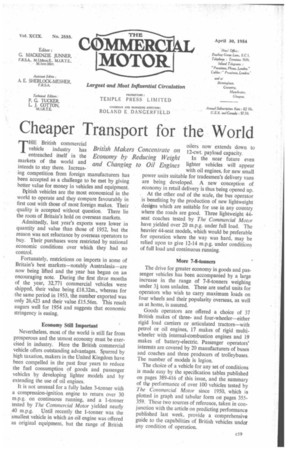Cheaper Transport for the World T HE British commercial vehicle industry
Page 69

If you've noticed an error in this article please click here to report it so we can fix it.
has entrenched itself in the markets of the world and intends to stay there. Increasing competition from foreign manufacturers has been accepted as a challenge to be met by giving better value for money in vehicles and equipment.
Wash vehicles are the most economical in the world to operate and they compare favourably in first cost with those of most foreign makes. Their quality is accepted without question. There lie the roots of Britain's hold on overseas markets.
Admittedly, last year's exports were lower in quantity and value than those of 1952, but the reason was not reluctance by overseas operators to buy. Their purchases were restricted by national economic conditions over which they had no control.
Fortunately, restrictions on imports in some of Britain's best markets—notably Australasia—are now being lifted and the year has begun on an encouraging note. During the first three months of the year, 32,771 commercial vehicles were shipped, their value being L18.32m., whereas for the same period in 1953. the number exported was only 26,423 and their value £15.56m. This result augurs well for 1954 and suggests that economic stringency is easing.
Economy Still Important Nevertheless, most of the world is still far from prosperous and the utmost economy must be exercised in industry. Here the British commercial vehicle offers outstanding advantages. Spurred by high taxation, makers in the United Kingdom have been compelled in the past four years to reduce the fuel consumption of goods and passenger vehicles by developing lighter models and by extending the use of oil engines.
It is not unusual for a fully laden 3-tonner with a compression-ignition engine to return over 30 m.p.g. on continuous running, and a 1-tonner tested by The Commercial Motor yielded nearly 40 m.p.g. Until recently the 1-tonner was the smallest vehicle in which an oil engine was offered as original equipment, but the range of British oilers now extends down to 12-cwt. payload capacity.
In the near future even lighter vehicles will appear with oil engines, for new small power units suitable for tradesmen's delivery vans are being developed. A new conception of economy in retail delivery is thus being opened up.
At the other end of the scale, the bus operator is benefiting by the production of new lightweight designs which are suitable for use in any country where the roads are good. Three lightweight 44seat coaches tested by The Commercial Motor have yielded over 20 m.p.g. under full load. The heavier 44-seat models, which would be preferable for operation where the way was hard, may be relied upon to give 12-14 m.p.g. under condition of full load and continuous running.
The drive for greater economy in goods and passenger vehicles has been accompanied by a large increase in the range of 7-8-tonners weighing under 3f tons unladen. These are useful units for operators who wish to carry maximum loads on four wheels and their popularity overseas, as well as at home, is assured.
Goods operators are offered a choice of 37 British makes of threeand four-wheeler--either rigid load carriers or articulated tractors—with petrol or oil engines, 17 makes of rigid multiwheeler with internal-combustion engines and 19 makes of battery-electric. Passenger operators' interests are covered by 20 manufacturers of buses and coaches and three producers of trolleybuses. The number of models is legion.
The choice of a vehicle for any set of conditions is made easy by the specification tables published on pages 389-416 of this issue, and the summary of thc performance of over 100 vehicles tested by The Commercial Motor since 1950, which is plotted in graph and tabular form on pages 355359. These two sources of reference, taken in conjunction with the article on predicting performance published last week, provide a comprehensive guide to the capabilities of British vehicles under any condition of operation.




















































































































































































































































